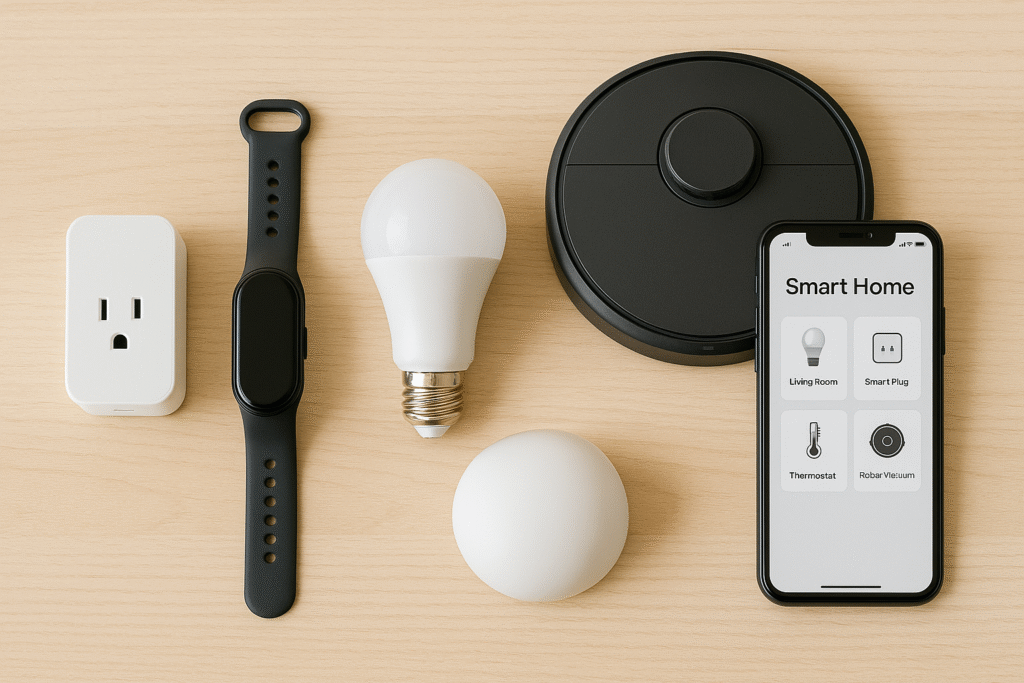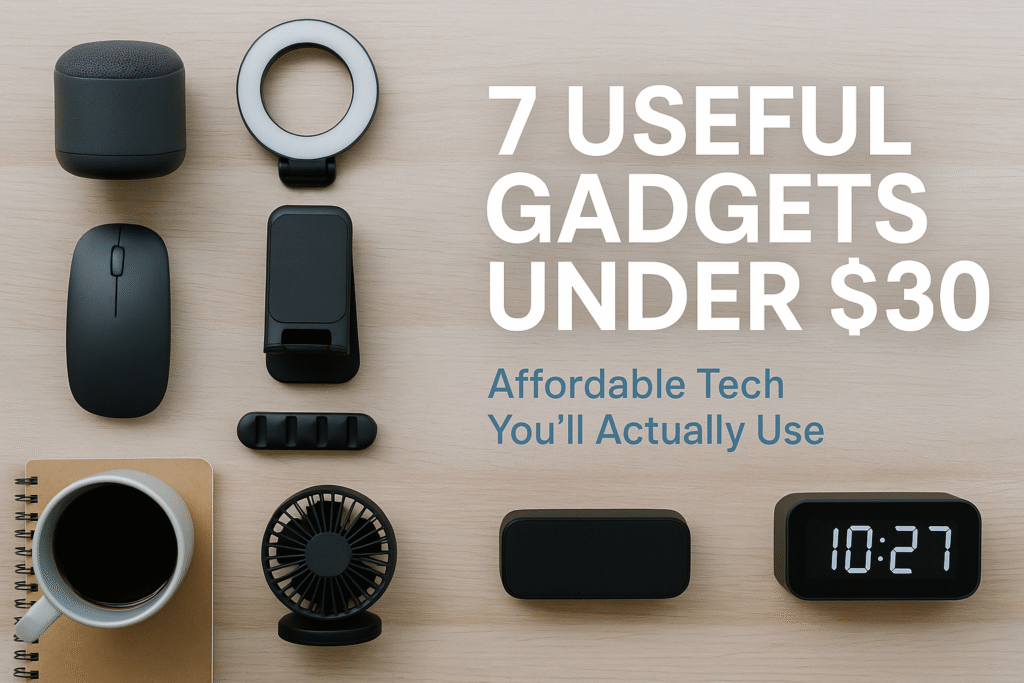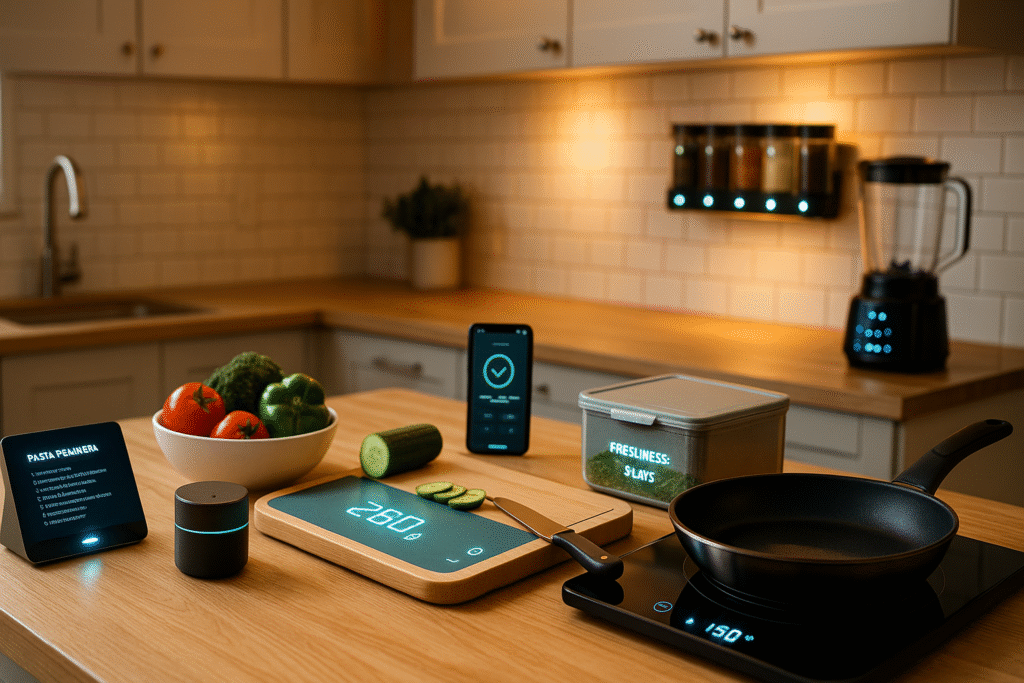1. Introduction: I’m Not a Techie — But I Love My Smart Devices
I’m not a tech person. I’ve never been the type to chase the latest gadgets or understand how every setting works on my phone. In fact, for years I avoided anything labeled “smart” — smart TVs, smart speakers, smart this, smart that. It all just felt too complicated and way out of my comfort zone.
But that changed when I got my first smart plug — a gift, actually. I plugged it in, connected it to an app, and suddenly I could turn my living room lamp on and off with my phone. No setup headaches, no tech skills required. It was simple, quick, and surprisingly fun.
That tiny gadget opened the door to a whole new world. I realized that smart devices for non-techies aren’t just a marketing gimmick — they really can make life easier without making it harder to figure out. Since then, I’ve added a few more beginner-friendly smart gadgets to my daily life, and I can say they’ve made things smoother, more organized, and even a little more fun.
If you’re like me — someone who doesn’t consider themselves “tech-savvy” — this post is for you. I want to share my experience with everyday smart technology and show how it can fit into your life even if you don’t know the difference between Bluetooth and Wi-Fi. No technical jargon, no pressure — just a real-life perspective from a regular person who found unexpected joy in smart living.
2. What Are Smart Devices
Let’s clear something up right away: smart devices aren’t just high-tech toys for engineers or gadget lovers. At their core, smart devices are everyday items — like plugs, lights, speakers, or even coffee makers — that connect to the internet or your phone to help you automate tasks, save time, or simplify daily life.
Think of a regular light bulb. Now imagine being able to turn that bulb on or off with your voice, your phone, or on a schedule. That’s a smart bulb — and yes, it’s really that simple. Most smart gadgets for beginners don’t require any special skills. If you can use a smartphone, you’re already qualified.
What makes these devices “smart” is their ability to communicate, either with each other or with apps you control. Many connect through Wi-Fi or Bluetooth and can be managed through voice assistants like Alexa or Google Assistant. But here’s the important part: you don’t need to be a tech wizard to use them. Most smart devices are designed with regular people in mind — including non-techies.
In fact, many of today’s most popular smart devices for non-techies come with simple plug-and-play setups, clear instructions, and user-friendly apps. Whether it’s controlling your fan without leaving the couch or setting your coffee to brew before you wake up, everyday smart technology is more accessible than ever.
So no — smart devices aren’t just for the tech elite. They’re for anyone who wants life to feel a little easier.
3. How I Got Started with Smart Devices
My journey into the world of smart devices for non-techies started with pure curiosity — and a bit of laziness. I was tired of getting out of bed to turn off the lights or searching for the TV remote in the dark. So when a friend gifted me a smart plug and said, “You’ll love this — even you can set it up,” I took it as a challenge.
I expected frustration. I thought I’d have to read some long manual, enter a bunch of codes, or mess with my Wi-Fi settings. But instead, I downloaded an app, followed three simple steps, and boom — I could turn my lamp on and off from my phone. It felt like magic. And more importantly, it didn’t feel like a headache.
That one experience broke the ice. Suddenly, the idea of trying beginner-friendly smart gadgets didn’t seem scary. I wasn’t “good with tech,” but I didn’t need to be. Everything was designed for people like me — clear instructions, helpful YouTube videos, and apps that actually made sense.
Next came a smart speaker, then a smart light bulb, and eventually a budget-friendly fitness tracker. None of it required any technical background, just a willingness to try something new. And each time, I got a little more confident.
If you’ve ever thought smart devices were too complicated, trust me — I was right there with you. But I’ve learned that tech for non-techies isn’t just possible — it’s the norm now. You just have to take the first (surprisingly easy) step.
4. Five Reasons I Fell in Love with Smart Devices
If you told me a couple of years ago that I’d be recommending smart devices to people, I would’ve laughed. Me? The person who still used a flip phone long after smartphones took over? But here we are. After a few months of experimenting with easy-to-use smart devices, I’m hooked — and here’s why.
4.1 They Actually Make Life Easier
This is the biggest reason I fell in love with them. Smart devices for non-techies aren’t just about looking fancy — they’re about solving everyday problems.
I can schedule coffee to start brewing at 6:30 AM, turn off lights without getting out of bed, and even ask my smart speaker to remind me about meetings or tasks. These little conveniences add up and genuinely make life smoother. There’s a reason they’re called “smart” — they save time and mental energy.
4.2 They’re Way Easier to Set Up Than You Think
One of the biggest myths about smart gadgets for beginners is that they’re hard to install or understand. But the truth is, most of them are designed to be plug-and-play. My first smart plug took less than five minutes to set up. My smart bulb came with an app that guided me step-by-step.
You don’t need a background in tech. You just need a smartphone and a little curiosity. And if you ever get stuck, there’s always a helpful tutorial on YouTube.
4.3 They’re Affordable
I used to think smart gadgets were expensive toys for people with fancy homes. But once I started looking around, I realized there are tons of budget-friendly smart devices out there. My smart plug cost less than $15. My smart light bulb? Around $10. I even found a smart fitness tracker for under $30 — and it works great.
You don’t need to invest in an entire smart home setup. Start small. Even one device can make a difference, especially if it solves a problem for you.
4.4 They Help Me Stay Organized
I’m not naturally organized. I forget things. I leave lights on. I miss reminders. But with smart devices, a lot of that is handled automatically. My smart speaker reminds me of appointments and tasks. My smart lights turn off when I leave the house. My smart plug shuts down my heater after an hour.
These aren’t just gadgets — they’re everyday smart technology tools that help me keep my life in order without constantly thinking about it. And I didn’t need to “learn tech” to get those benefits.
4.5 They Made Me More Open to Technology
Before smart devices, I felt left out of tech conversations. Everyone seemed to know more than me. But once I started using tech for non-techies, I began feeling more confident. I didn’t suddenly become a tech expert, but I did start to see that technology isn’t scary — it’s just about finding what works for you.
Smart gadgets gave me control and confidence. I could customize my routines, simplify chores, and even impress friends who thought I was still living in the stone age.
Final Thoughts on the Benefits
Smart devices are no longer just “futuristic” toys. They’re real tools that help regular people — especially non-techies — live better. Whether you want to save time, stay organized, or simply avoid walking across the room to turn off a lamp, there’s probably a smart device that can help.
And the best part? You don’t need to be a tech expert to fall in love with them. You just need to try one.
5. My Favorite Beginner-Friendly Smart Gadgets
Now that I’ve tried several smart devices, I can confidently say: not all gadgets are created equal — especially when you’re just starting out. Some are overly complicated or packed with features you’ll never use. Others? Absolutely perfect for beginners.
So, if you’re wondering which smart devices for non-techies are actually worth it, here are my personal favorites that made my transition into smart living smooth and stress-free:
5.1 Smart Plug
This was my very first smart device — and it’s still my favorite. Just plug it into your wall socket, connect it to a simple app, and you can control anything plugged into it (like a lamp, fan, or coffee maker) from your phone.
It’s an easy way to automate your home without changing your existing appliances. Plus, it’s one of the most beginner-friendly smart gadgets out there.
5.2 Smart Light Bulb
This one blew my mind. I replaced a regular bulb with a smart one, connected it to Wi-Fi, and instantly had control over brightness and color — all from my phone. You can even schedule it to turn on/off automatically.
Perfect for lazy mornings, or just making your room feel futuristic.
5.3 Smart Speaker with Voice Assistant
I use a basic model with Google Assistant, and it helps with reminders, weather updates, music, and random questions I’d normally Google. You just speak — no typing or navigating apps needed.
This device helped me experience the power of everyday smart technology without ever touching a screen.
5.4 Budget Fitness Tracker
You don’t need an expensive smartwatch to track steps, sleep, and heart rate. I found a simple tracker for under $30 that syncs with my phone and gives me a daily health snapshot. No tech skills required.
These gadgets proved that tech for non-techies is not only possible — it’s fun, useful, and surprisingly affordable.
7 Useful Gadgets Under $30 You Can Actually Use Daily

6. Common Misconceptions About Smart Devices
Before I started using smart devices, I had a few assumptions — and most of them were totally wrong. If you’re hesitant to try them, chances are you’ve heard (or believed) some of these myths too. Let’s clear the air.
“You Need to Be Tech-Savvy”
This is the biggest misconception — and the one that held me back the longest. I thought smart devices were only for people who could code or configure networks. Not true. Most smart devices for non-techies are designed for everyday people. If you can use a smartphone, you can use a smart device.
“They’re Too Expensive”
Sure, some smart home setups cost a lot. But that’s not what we’re talking about here. You can easily start with budget-friendly, easy-to-use smart devices under $30 — and they’ve been game-changers.
“It’s Just a Trend”
Smart devices aren’t just trendy tech toys. They solve real problems, save time, and make life easier. That’s why they’re here to stay — especially as tech for non-techies becomes more accessible and mainstream.
“They’re Complicated to Set Up”
Many smart gadgets now come with step-by-step apps, plug-and-play features, and built-in voice assistants. I set up most of mine in under 10 minutes — no manuals, no stress.
Bottom line: smart devices for non-techies are real, useful, and designed for people just like you and me — not just for tech experts.
7. Final Thoughts: You Don’t Need to Be a Tech Expert to Enjoy Smart Living
If there’s one thing I’ve learned on this journey, it’s this: you don’t need to be a tech expert to enjoy smart devices. You just need a little curiosity and the willingness to try something new.
I used to think smart gadgets were for engineers or people with smart homes full of screens and codes. But now I know they’re for people like me — and you. Regular folks who just want life to be a little easier, a little more organized, and maybe even a little more fun.
There are so many smart devices for non-techies out there now that are designed specifically with simplicity in mind. From smart plugs to light bulbs to speakers and trackers, the setup is often as easy as downloading an app and tapping a button. No headaches. No tech degree required.
If you’ve been sitting on the fence, here’s my tip: start small. Pick one beginner-friendly smart gadget that solves a real problem for you — like forgetting to turn off the lights or needing reminders throughout the day. Try it out. See how it feels.
Chances are, once you experience how simple and helpful it is, you’ll fall in love with easy-to-use smart devices.
So go ahead — give smart living a try. You might be surprised how “techy” you already are.
8. Bonus Tip: How to Choose the Right Smart Device as a Beginner
Feeling ready to try smart living, but not sure where to start? Don’t worry — choosing your first smart device for non-techies doesn’t have to be overwhelming. Here’s the simple approach I used when I was just starting out.
8.1 Start with a Need, Not a Trend
Instead of buying the latest flashy gadget, ask yourself: What would actually make my day easier?
For me, it was controlling my lights without getting up. For you, it might be remembering appointments, automating appliances, or tracking your steps.
When your first smart device solves a real problem, it becomes instantly valuable.
8.2 Look for Plug-and-Play Simplicity
Search for easy-to-use smart devices that are known for quick setup and user-friendly apps. Look for reviews that mention phrases like “works out of the box” or “great for beginners.”
Smart plugs, bulbs, and speakers are great beginner-friendly smart gadgets because they’re simple, useful, and affordable.
8.3 Stick to One Ecosystem (at First)
Whether it’s Google, Amazon Alexa, or Apple HomeKit — start with one platform so your devices work well together. Mixing too many systems early on can be confusing.
Choosing your first smart gadget should feel exciting, not stressful. Stick with tech for non-techies, and you’ll be surprised how quickly it becomes part of your everyday life — no tech skills required.
Have a favorite smart gadget that made your life easier? Drop it in the comments or share this post with a fellow non-techie!



